Draft Sectoral Marine Plans for Offshore Renewable Energy in Scottish Waters - Environmental Report Appendix B: Baseline Information
Appendix B to the SEA Environmental Report of the Draft Sectoral Marine Plans for Offshore Renewable Energy in Scottish Waters.
This appendix contains Baseline Information.
1.6 Marine Geology and Coastal Processes
Key Issues Summary
- Potential for increased vulnerability of coastal areas from changes in coastal processes related to marine activities, and also from climate change.
- Pressures from the development of coastal areas
- Potential impacts of marine activities on seabed sediments and natural processes, and their ability to support habitats and species.
- Potential for impacts on marine and coastal areas designated for their geological importance.
Designations
1.6.1 Many of Scotland's coastal and offshore marine protected sites (see Biodiversity section) cover important coastal and marine habitats [170] . Whilst some degree of protection can be afforded to marine geology features through SAC and SPA designations and the designation of coastal SSSI which offers the primary mechanism of protection for terrestrial and coastal sites to the seaward limit of local authority areas. Scotland's SSSI are underpinned by the Geological Conservation Review ( GCR) undertaken by the JNCC [171] .
1.6.2 Together, these designations will contribute to the development of Nature Conservation MPAs which will protect important areas of marine habitat, geology and geomorphology in Scottish waters [172] .
North East
1.6.3 There are several GCR sites along the North East coastline, with two main areas extending along the coast of the Dornoch Firth, with a smaller area of designation near Portmahomack. Other designated areas are located along the eastern coastline to the north and south of Aberdeen, and sections of the along the coastline from Fraserburgh to Lossiemouth (see Figure B1.6.1).
Figure B1.6.1: GCR sites in the North East
Geological Conservation Review sites. North East area
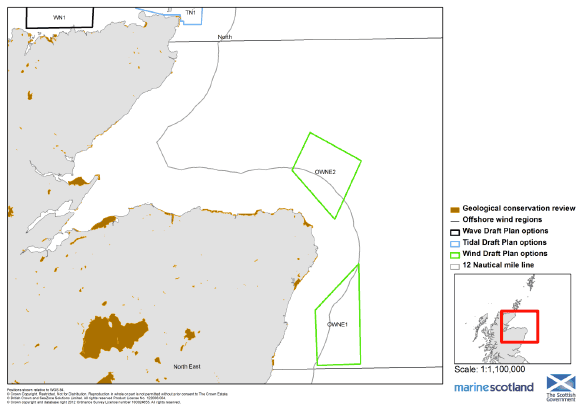
North
1.6.4 There are GCR sites located along numerous coastlines in Shetland, including several designations located at Brae in the north west of the island. The entire coast surrounding the island of Foula is also designated. In Orkney the southern tip of Hoy and the coastline to the west of Stromness are the main areas of designation.
1.6.5 There are also concentrations of GCR sites extending along the north mainland coastline near Durness and around Loch Eriboll, which continues further inland past Tongue. There are some smaller areas further along the coastline near Thurso and Castleton, and near the furthest tip of the mainland at Cape Wrath (see Figure B1.6.2).
Figure B1.6.2: GCR Sites in the North
Geological Conservation Review sites. North area
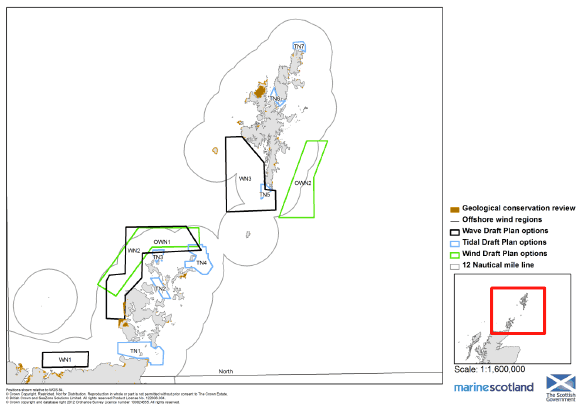
North West
1.6.6 GCR sites are scattered along the coast from Cape Wrath at the northern point of the Scottish mainland, southwards to Ullapool. In the Western Isles, there are small GCR areas on the north west coast of Lewis, in the north east region of Harris, in the north east and north west regions of North Uist, and smaller designations on the south coastline of Barra. The whole coastline of St Kilda is also designated as a GCR site (see Figure B1.6.3).
Figure B1.6.3: GCR Sites in the North West
Geological Conservation Review sites. North West area
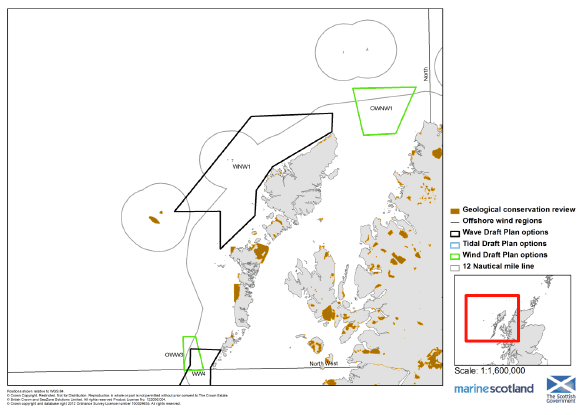
West
1.6.7 GCR sites have been identified in the vicinity of plan option areas at the south west tip of the Isle of Mull, along much of the west coast of Jura, and large areas have been identified along both the north west coastline of Islay including offshore areas to the north west (see Figure B1.6.4).
Figure B1.6.4: GCR Sites in the West
Geological Conservation Review sites. West area
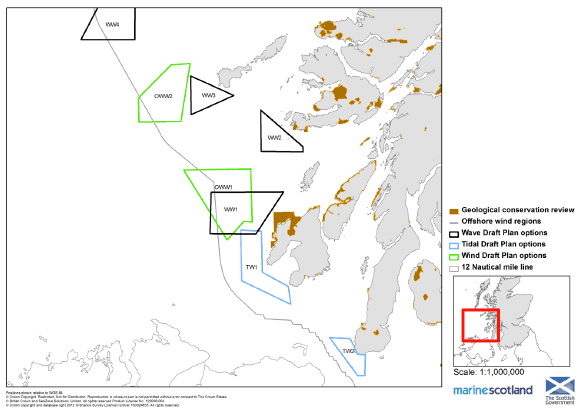
South West
1.6.8 There are areas of GCR designations scattered along the Solway coast. The largest of these areas are located in coastal areas in Luce Bay and Wigtown Bay, with pockets of smaller designations at the coast by Kirkcudbright and further inland from the Solway Firth (see Figure B1.6.5).
Figure B1.6.5: GCR Sites in the South West
Geological Conservation Review sites. South West area
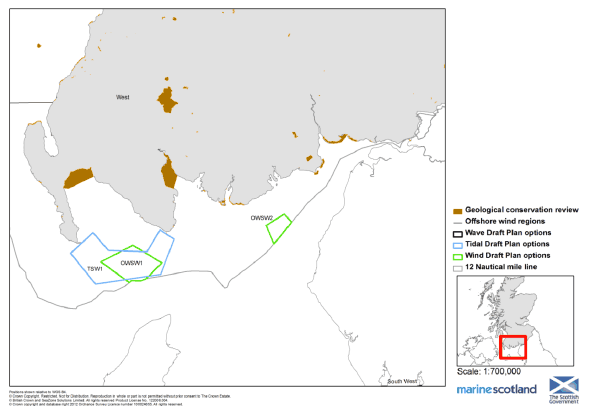
Soils and sediments
1.6.9 Much of Scotland's landscape and coastline was initially formed through the processes of glacial erosion and deposition [173] , and even today, the land continues to change through coastal processes such as wave action, sediment movement, erosion and accretion [174] . The 2004 Eurosion survey of Scotland's coastline reported that it comprises predominantly hard coasts consisting of rocks and cliffs (70%); soft coasts considered potentially susceptible to erosion impacts, consisting of unconsolidated gravels, sand and silts (29%); and artificial coasts such as harbours and sea walls (less than 1%) [175] .
1.6.10 The offshore environment in Scottish waters ranges from shelf sea areas to deep ocean regions with depths greater than 2,000m. The continental shelf includes the Malin and Hebrides Shelf Seas, Orkney and Shetland Shelf Seas, and the North Sea. The shelf seas are marked by notable features such as banks ( e.g. Stanton Banks, Viking Bank) and deep channels.
1.6.11 In general, the marine sediments around Scotland are sandy or gravelly and originate from deposits created during the Quaternary glaciation. Strong currents and wave action may also have prevented deposition of recent muddy sediment or winnowed it to leave a coarse-grained lag deposit. Muddy sediments principally occur near-shore or further offshore, in depressions on the sea floor, where currents may be relatively weak. They also occur beyond the shelf break (200m water depth) to the west of the Western Isles. The concentration of calcareous material varies greatly in seabed sediments reflecting the amount of shell material in different areas; locally, they can be very high [176] .
Scotland's Bathymetry
1.6.12 The bathymetry of Scottish waters shows a sharp distinction between the east and west coasts. The east coast bathymetry presents mostly uniform depths and shallow inclines interspersed with localised trenches. The water deepens to the east towards the North Sea to an average of around 100m, with deeper sections of up to 200m present in some locations ( e.g. the south east Moray Firth, the Devil's Hole and 110 mile Holes). These depths also increase to the north of the Shetland Isles, where the average depth is estimated to be around 110m inshore of the shelf edge.
1.6.13 In contrast, the seabed off Scotland's west coast shelves steeply away from the coast, and deep waters occur relatively close to the land, contrasting the shallow shelving found to the west of the Outer Hebrides. The west coast bathymetry has been deepened by glacial scouring, as demonstrated by sea lochs such as those in the Argyll and Bute area, and depths can be highly variable. Beyond shallow coastal areas, it is estimated that the average depth is around 60m off Scotland's west coast, although a wide range of depths between 10 - 320m have also been identified in some areas.
1.6.14 The shelf edge or western trench creates a natural bathymetric demarcation that borders Scotland to the west. This trench starts at between 40 and 60 miles west of the Outer Hebrides, and follows a broadly north-south direction off the west of Scotland, and a northeast-southwest direction further to the north. Depths generally increase rapidly offshore, roughly ranging from 200m to greater than 2,000m [177] . Data from the British Geological Society ( BGS) demonstrates that Scottish waters display a wide range of seabed habitats, ranging from scoured rock or coarse sediment to muddy gravel or fine sand in some areas.
Coastal Change
1.6.15 There is a strong interaction between wave, tide and current energy, and the processes of erosion and sedimentation. For example, these processes can aid stability of soft shorelines through the supply of sediment, and can reduce stability through the removal of sediment.
1.6.16 Coastal erosion and accretion are significant problems affecting many coastal communities, both in Scotland and around the world. While natural wave action, tidal currents and drainage have typically been the main drivers of coastal erosion, in more recent times, human activities ( i.e. land reclamation, coastal or offshore, etc.) and natural disasters have also played a significant role in exacerbating these natural processes [178] .
1.6.17 The Marine Climate Change Impacts Partnership ( MCCIP) estimated that in 2010-11, around 7% of Scotland's coast was protected by engineering or artificial structures [179] . The use of engineered sea defences and softer solutions such as the managed realignment of coastlines may become increasingly important in the future with additional pressures from rising sea levels and erosion/deposition associated with climate change [180] . Of the estimated 429km of artificial coastline on Scotland's mainland, some 307km is part of our coastal defences with the remainder being other developments ( i.e. piers and harbours) [181] . However, these sea defences themselves can also have adverse effects on the coast. For example, inappropriate defences can transfer erosion issues further along the coast [182] , and offshore developments have the potential for creating similar effects.
1.6.18 The Eurosion project undertaken in 2004 categorised Scotland's coast and summarised the nature of the coastline, whilst assessing its potential stability and behaviour (See Figure B1.6.6). This assessment found that three quarters of Scotland's coast was considered broadly stable, 8% was considered accretional [183] . In 2010-11, it was estimated that 12% of Scotland's coastline was erosional [184] . As shown in Figure B1.6.7, the sections of Scotland's coastline identified as being subject to either erosion or accretion include key areas along the east coast between Montrose to Dunbar, the Firth of Clyde, the inner Moray Firth, and parts of the Northern and Western Isles. Coastal protection plans have been introduced in some of these areas [185] . The erosional portion of coastlines largely consists of beaches, sand dunes, conglomerates/soft-rock cliffs, machair and marshes with muddy sediments [186] .
Figure B1.6.6: Eurosion Coastal Survey and Erosion Potential
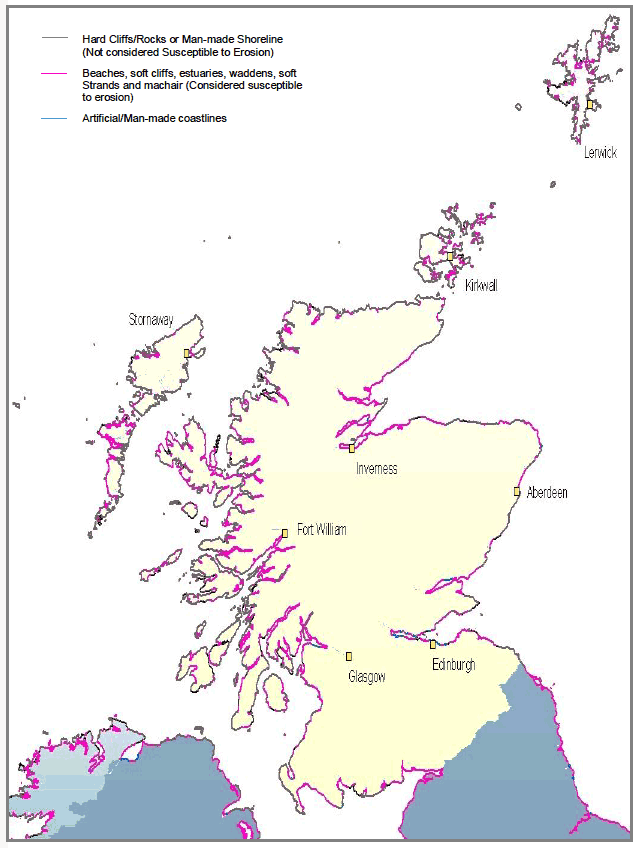
Figure B1.6.7: Eurosion Coastal Erosion Survey 2000
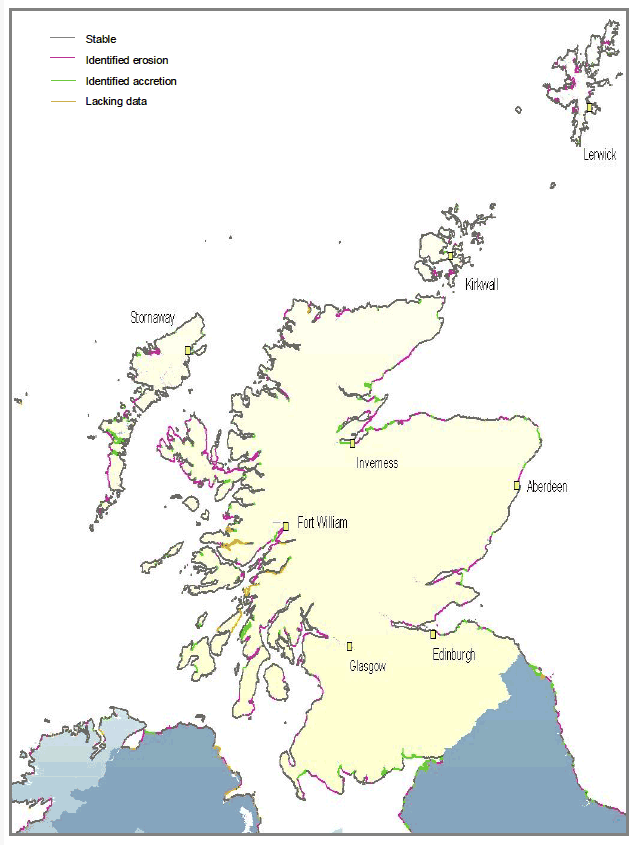
Dredging and Disposal
1.6.19 Historically, the marine aggregate extraction industry has been small in Scotland, largely due to a lack of suitable and readily accessible resources on the seabed, and an adequate supply of land available. However, as of 2011, two marine aggregate production areas were located in Scottish waters.
1.6.20 The first and largest is in the Firth of Forth, licensed for the extraction of up to 6 million cubic metres over 10 years, although with only one extraction to date of nearly 130,000 tonnes (86,260m3) for use as in-fill in the Leith Western Dock Reclamation Project in 2005. The second area is located in the Firth of Tay, although this region has not been used for several years. However, it is estimated that the Firth of Tay site could supply some 66,000m3 a year [187] .
1.6.21 While in the past, a wide range of materials have been disposed at sea ( e.g. industrial wastes, colliery mine-stone and sewage sludge), only the disposal of dredged material from ports, harbours and marinas is currently permitted. In 2009, there were some 66 open sites designated and routinely used for marine disposal within Scotland, with a further 50 sites either closed or disused [188] .
1.6.22 While the volume of material disposed of remained relatively constant between 2005 and 2009, a total of around 3.8 million tonnes of dredged spoil was deposited in designated disposal sites in Scottish waters in 2011, a significant increase from the 2009 total of around 2.5 million tonnes. This equated to around 40% of the allowable total of over 10.2 million tonnes that could have been deposited under licence [189] . Most of the disposal since 2005 - 2011 has been undertaken in designated areas near to the highest densities of population and industry [190] ( e.g. the Firth of Forth, the Clyde and off Scotland's east coast) [191] .
Spatial Bathymetry and Seabed Baseline Information
1.6.23 Greater detail on spatial bathymetry and sediment composition predicted by European University Information Systems ( EUNIS) habitat data is presented in the Wind, Wave and Tidal Regional Locational Guidance ( RLGs).
North East
Aberdeenshire East Coast
1.6.24 The seabed off the Aberdeenshire east coast consists predominantly of sand near to the coast, with coarser sediments including gravelly sands further offshore. The EUNIS predicted habitats dataset classifies these areas as infralittoral and circalittoral fine or muddy sands near-shore to deep circalittoral sand and circalittoral coarse sediment offshore, with depths ranging from 60m to 110m offshore.
North East Coast
1.6.25 The sediment composition changes somewhat approaching the north east tip of the Scottish mainland, with sandy gravel found located near the coastline, interspersed with large pockets of slightly gravelly sand and gravelly sand near to the tip, and sandy gravel, sand and muddy sand areas to the west towards the Moray Firth. The EUNIS dataset classifies the area as deep circalittoral sand and coarse sediment at the north east tip of the mainland, to circalittoral muds to the west. There is a sharp increase in depth to the north of this area, 60 - 200m at its deepest, due to the presence of the Moray Firth trench.
North
Shetland
1.6.26 The seabed surrounding the Shetland Isles consists mainly of coarse sediments such as sandy gravels and gravelly sands, with areas of sand identified to the south west, east and south east of the Isles. The EUNIS dataset describes the seabed habitats as predominantly deep circalittoral coarse sediments and sands, with some areas of deep circalittoral rock to the east of the isles. The depth of the seabed varies from shallow areas near to the Shetland coast to around 130m at some points within the plan option areas.
Orkney
1.6.27 The seabed surrounding the Orkney Isles consists mainly of coarse sediments such as sandy gravels and gravelly sands, with some patches of sandy sediments to the south west and south east of the Isles, and undifferentiated rock in the narrow section of the Pentland Firth between Orkney and the mainland. The EUNIS dataset describes the area as being generally composed of circalittoral coarse sediments, deep circalittoral coarse sediments and sands all around the Isles, with the exception of deep moderate and high energy circalittoral rock within the narrows of the Pentland Firth. The dataset also predicted infralittoral and circalittoral coarse sediments in the vicinity of the tidal energy area of search within the Stronsay and Westray Firths.
1.6.28 The depth of the seabed varies from 30 - 170m around and within the Isles, the deepest areas being located to their north west beyond the offshore wind and wave plan option areas.
North Mainland
1.6.29 The seabed in the Pentland Firth consists of undifferentiated rock in the narrow section of the Firth between Orkney and the mainland, with coarse sediments including sandy gravels, gravelly sands and sands to the west along the North Sutherland Coast and to the east of the Pentland Firth. The EUNIS data describes the area as deep moderate and high energy circalittoral rock within the narrows of the Firth, with shallow and deep circalittoral coarse sediments to the east and west, interspersed with circalittoral fine or muddy sand pockets offshore of the North Sutherland Coast. Depths vary from 20 - 100m in the Pentland Firth and off the North Sutherland coast, with the narrows of the Firth the shallowest part.
North West
North West Mainland (Cape Wrath)
1.6.30 The seabed beneath the North Minch, bordered by Cape Wrath to the south east and Lewis to the south west, consists largely of coarse sediments including sands, gravelly sands and sandy gravels. The EUNIS data describes the area as circalittoral coarse sediments and sands with areas of finer sediments near to the Cape Wrath and Lewis coastlines, and with deep circalittoral coarse sediments and deep circalittoral sands found further to the north of the Minches. Depths vary from 50 to 140m across the area, with the deeper areas generally located within the western part of the offshore wind area of search and in the central and western parts of the North Minch.
Western Isles (West of Lewis)
1.6.31 The seabed to the north west of Lewis consists mainly of sandy and gravelly sediments, with large areas of undifferentiated solid rock outcrops to the west of Lewis and to the north west of Uist, that create a 'V shape' around sandy and gravelly sediment areas. The EUNIS data classes these rock outcrops as low energy circalittoral rock, and the sandy and gravelly sediment areas as circalittoral and deep circalittoral coarse sediments. Depths in this region range from 30 to 140m with an average depth of around 80m within the wave energy area of search ( WNW1).
Western Isles (West and South West of Barra)
1.6.32 The seabed to the west of the southern tip of the Outer Hebrides consists mainly of undifferentiated rock outcrops to the immediate west of Barra, with sandy and gravelly sediments further west and south. The EUNIS data confirms this description but differentiates between the rock outcrops, classing the easternmost part of this rock outcrop as low energy infralittoral rock, the central region as low energy circalittoral rock, and the westernmost part as deep moderate energy circalittoral rock. The remainder of the seabed sediments are predicted to be predominantly circalittoral coarse sediments and sands. The depths around this region are highly variable, ranging from 20 to 120m with an estimated average depth of around 80m.
West
Barra to Islay
1.6.33 The seabed in this large area is composed mainly of sandy sediments to the north, giving way to coarser gravelly sand and sandy gravel in the shallower waters north of Islay, with coarser gravels in some areas west of Islay. The EUNIS data classified these habitats as circalittoral sand or muddy sands with infralittoral coarse sediments or rock to the south west of Tiree, getting coarser to the south with circalittoral coarse sediments and deep circalittoral coarse sediments predicted.
1.6.34 Depths in this large area are highly variable, reaching over 100m to the south west of Islay.
Islay to Kintyre
1.6.35 The seabed in this large area is composed mainly of coarse sediments such as gravels, sandy gravels and gravelly sands near Islay, giving way to more coarse sediments including sandy gravels, albeit with a small area of muddy sandy gravel identified southwest of the Kintyre peninsula. Mud and muddy sand sediments were predicted in the region between Kintyre and Jura. The EUNIS data describes this area in much the same way, with circalittoral coarse sediments near Islay and deep circalittoral coarse or mixed sediments predicted in the south west. It describes the area between Jura and the northern portion of the Kintyre Peninsula containing deep circalittoral sand or mud. Depths vary markedly within this region, reaching around 150m at the extent of Scottish territorial waters in the North Channel.
South West
Solway Firth
1.6.36 The seabed within the Solway Firth is varied, ranging from mixed coarse sediments such as sandy gravels, gravelly sands and some gravelly muddy sands to the south west of the Mull of Galloway and to the south of Wigtown Bay, to coarser sediments in waters south of Luce Bay. Finer sediments including extensive sandy and muddy sand sediments are located further east in the Firth to the east of the River Dee, whilst muddy sandy gravel sediments are located within Luce Bay itself, and finer muddy sand and mud sediments are located within neighbouring Wigtown Bay. The EUNIS data confirms this, predicting habitats of circalittoral coarse sediments to the south west of the Mull of Galloway, circalittoral coarse and mixed sediments to the south of Luce Bay, infralittoral fine sand or muddy sand within Luce Bay, and predicted circalittoral fine sand, mud and muddy sands within Wigtown Bay and further east in the Firth.
1.6.37 This area south of the Luce Bay and Wigtown Bay shows shallow bathymetry of 20-60m deepening in an east-west direction where it deepens rapidly, reaching depths of 140m at the extent of Scottish Territorial Waters in the North Channel.
Contact
There is a problem
Thanks for your feedback